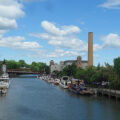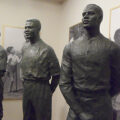By Renée S. Gordon
Albany began as the Dutch West India Company’s northernmost Dutch settlement. In 1614, less than 10 years after Henry Hudson’s explorations, a small building was constructed on Castle Island to store trade goods and house approximately 12 men. Inside a moated stockade stood a small wooden structure, 36-ft. by 26-ft., known as Fort Nassau. The fort flooded, was relocated and then abandoned in 1618. In 1624 a second trading fort was built on the west side of the Hudson River. Fort Orange quickly became the premier fur trade center on the continent.
By 1652, the colony around the fort was referred to as Beverwyck and it was so called until New Netherland was taken over by the British in 1660 and was renamed Albany. For a very brief period, 1673-74, the settlement again fell to the Dutch and they called the area Willemstadt. For the final time it was renamed Albany under British jurisdiction in 1674. Twelve years later Albany, one of the oldest cities in the country, received its charter and in 1797 became the capitol of New York State.
Albany has managed to maintain much of its Dutch heritage as evidenced in the place and surnames and architecture. The city’s signature event is the annual Tulip Festival. More than 210,000 tulip blooms dazzle the eye in Washington Park. The festival begins with the scrubbing of State Street, a Dutch pre-festival tradition, and proceeds with the coronation of the Tulip Queen and her Court. Musical performances, vendors and child-focused activities add to the fun. The 65th Tulip Festival will be held May 11-12, 2013. www.albanyevents.org
Two significant structures that date from the Dutch era are the First Church of Albany and the Quackenbush House. The extant First Church replaced the Reformed Protestant Dutch Church and dates from 1798. The building features the oldest pulpit in the country. It was handcarved in Holland, with its own hourglass, in 1656. The original church was constructed as a blockhouse and situated in the middle of the street to serve as a fortress and a place of worship.
The Quackenbush House was constructed in 1736 in Dutch vernacular style. Subsequent owner Hendrick Quackenbush altered it in 1790 to reflect Federal style architecture. It is the second oldest structure in the city and currently houses a restaurant.
The Albany Heritage Area Visitors Center (AHAVC) is single stop venue for souvenirs, information, services and an overview of the city and its history and culture. Visitors should tour the museum in the center beginning with the orientation film and then walking a winding chronological path that takes you through Albany’s history from pre-contact to the modern era. Of particular note is the mini-gallery devoted to the antebellum black community and their association with the abolitionist cause and the Underground Railroad (UGRR). www.albany.org/visitors-center
UGRR History Walking Tours begin at the AHAVC and are under the auspices of the UGRR History Project of the Capitol Region. Tours are comprehensive, last approximately 90-minutes and can be customized. The highlight of the tour is a stop at the Stephen and Harriet Myers Residence currently in the process of restoration.
John Johnson, an African American boat captain who operated a sloop between NY City and Albany, built the three story brick house in 1847. The Myers purchased the home in the 1850s. The Vigilance Committee met in the front parlor and many of the important abolitionists of the era passed through the home as well as freedom seekers. The Vigilance Committee coordinated area efforts for the benefit of the fugitives, often paying black neighborhood residents to house them. www.undergroundrailroadhistory.org
Established in 1836, the New York State Museum is the oldest and largest in the country, with more than 12-million objects in the permanent collection. Highlights of the collection are an authentic subway car, a portion of the Sesame Street stage set, a Harlem gallery and the September 11th trailer used as a waiting area for the family members of victims. The trailer is filled with personal items and it is easily the most poignant exhibit in the museum.
The 7,000-sq. ft. “An Irrepressible Conflict: The Empire State in the Civil War” exhibition will be on view until September 22, 2013. More than 200 artifacts, documents and photographs can be see in this outstanding display. Visitors proceed through three chronological sections, “Antebellum New York,” “The Civil War” and Reconstruction and Legacy.” This holistic approach to New York’s place in the Civil War gives voice to all participants and allows viewers to experience both the battlefield and the homefront.
More than 20 institutions and private collectors have loaned objects to the museum for this exhibit. Not to be missed are an 1806 inscribed brass slave collar, items made in Elmira Prison Camp, an 1864 visiting card that belonged to Sojourner Truth, an 1864 regimental hospital ledger and a 1920s Ku Klux Klan robe. The museum is open daily except for Thanksgiving, Christmas and New Year’s Day. Admission is free. www.nysm.nysed.gov
U.S. Route 20, part of the 3,300-mile Transcontinental Highway, is a designated NY State Scenic Byway. The 108-mile portion that runs through Central NY is a feast of lakes, small towns, undulating hills, historic sites and attractions and, this time of year, brilliant fall foliage. I strongly suggest that you take this leisurely ride to Madison County, the next destination.
There are 20 official UGRR sites in Madison County and two of the state’s most significant are in the small town of Peterboro, the Gerrit Smith National Historic Landmark and the National Abolition Hall of Fame. Both sites are also listed on the National Park’s Network to Freedom.
Gerrit Smith is believed to have been one of the wealthiest men and greatest philanthropists of his time. His father was Peter Smith, a partner in the fur trade with Jacob Astor, and his fortune was immense. In 1817 Smith graduated from college and in 1819 Peter turned over the management of his holdings to him. At one point he managed an estate of more than 750,000-acres. Smith appears to have become increasingly more radical as he grew older and his estate was the site of visits by Douglass, who dedicated his first autobiography to him, Tubman, Truth, Elizabeth C. Stanton, Peter Still, John Brown and numerous fugitives.
In 1846, he financed a black settlement, Timbucto, and granted 3,000 individuals 40-acres of land in the Adirondacks. He gifted the struggling Oberlin College with $2000 and 20,000-acres of land and helped finance his friend John Brown’s raid on Harper’s Ferry. After the raid a bank draft from Smith was found and letters that indicated him in the plot and had his family not had him institutionalized in the Utica state asylum he would have been indicated in the plot. It has been estimated that Gerrit Smith’s contributions to the antislavery cause amounted to as much as $1 billion in 2012 dollars. Intriguingly, on May 13, 1867 Smith was one of the co-signers on Jefferson Davis’ $100,000 bail bond.
A tour of the Gerrit Smith National Historic Landmark is both impressive and humbling. The complex consists of three structures and interpretive panels that feature a timeline, historical information and personal stories. Tours begin in the Visitor Center with a 20-minute orientation video and move to the exterior exhibits.
The barn showcases Smith’s family life and is filled with documents, photographs and informational plaques. The Land Office functioned as Smith’s workplace and has the original flooring and cabinets and it is inspiring to think of all the people who trod these boards before you. www.gerritsmith.org
Just down the street from the estate, housed in the Smithfield Community Center, is the National Abolition Hall of Fame & Museum. The mission of the NAHOF is to recognize the contributions of and pay homage to the abolitions that dedicated their efforts to the 19th century antislavery cause. A 10-minute video provides background information on the importance of the center.
On October 21, 1835, 400 delegates attended the first meeting of the NY State Anti-Slavery Society in Utica. They were driven out by a mob and Gerrit Smith offered them Peterboro, 30-miles away, as a location for their meeting. They reconvened on the 22nd in the Presbyterian Church, now the Smithfield Community Center, and the society was formed.
On the 2nd floor the Hall of Fame inductees are pictured on banners by the year of their inclusion. The inaugural group of inductees, Frederick Douglass, William Lloyd Garrison, Lucretia Mott, Gerrit Smith and Harriet Tubman, were installed in 2005. www.nationalabolitionhalloffameandmuseum.org
Gerrit Smith is interred in the integrated Peterboro Cemetery along with many ex-slaves. His gravestone is smaller, by choice, than many of theirs.
Madison County was home to the utopian Oneida Community from 1848-80. The group was founded by John Noyes and moved to NY from Vermont. The religiously based community believed that selfishness was the cardinal sin, that man had the potential to become sinless as was Christ, the Second Coming had occurred and men and women were equal. At its height the community numbered about 300. The Oneida Community was economically successful and when it disbanded all the assets were divided and members became stockholders. www.oneidacommunity.org
The 93,000-sq. ft. Mansion House, a National Historic Landmark, offers tours that allow visitors a glimpse into the history and lifestyle of the community. A museum room features a model of the mansion house, memorabilia, artifacts and portraits that provide an overview. Other areas of interest are the library, individual rooms, meeting room, and a display of Jessie Kinsley’s stunning braided silk artworks. The Mansion House also offers overnight lodging with breakfast and rental spaces. www.oneidacommunity.org/facilities
The Chittenango Landing Canal Boat Museum is situated inside the Old Erie Canal State Historic Park. This museum complex relates the history of the construction of the canal and the canal boats and the lives of the workers. Tours begin in the Visitor Center with photographs, maps and artifacts that explain everything from the impediments to starting construction in 1817 to the impact of its completion in 1825.
Fifteen outdoor exhibit areas allow you to experience life along the canal as you climb inside a canal boat, visit the mule stable and peer into the Drydock area. Highlights of the tour are a visit to a life-sized mercantile store display and an opportunity to step inside the cargo hold. www.clcbm.org and www.chittenangolandingcanalboatmuseum.com
You can literally follow the Yellow Brick Road down the main street of Chittenango to the All Things Oz Museum. Frank L. Baum, author of “The Wizard of Oz,” was born here and his memory is preserved in this delightful museum. Only 25 percent of the collection is on view at any given time but you will love what you can see. There are numerous photographs, books, memorabilia, an area devoted to André DeShields portrayal of “The Wiz” on Broadway and a jam-packed gift shop.
“Oz-Stravaganza,” a celebration of gigantic proportions, is presented annually. Believe it or not there was actually a tornado during the 2010 event. www.oz-stravaganza.com
Madison County has it all and we have only scratched the surface. Madison’s annual Bouckville Antique Week brings together more than 2000 vendors and dealers and culinary destination choices are available online. www.madfoods.com
Information on planning a trip to Albany can be found at www.albany.org, Madison County at www.madisontourism.com and the State of New York at www.iloveny.com
I wish you smooth travels!
Travel Tip:
A good read in preparation for a trip to UGRR sites in New York is “Practical Dreamer,” a biography of Gerrit Smith by Norman K. Dann. www.amazon.com/Practical-Dreamer-Gerrit-Crusade-Social/dp/0975554875

















Leave a Comment